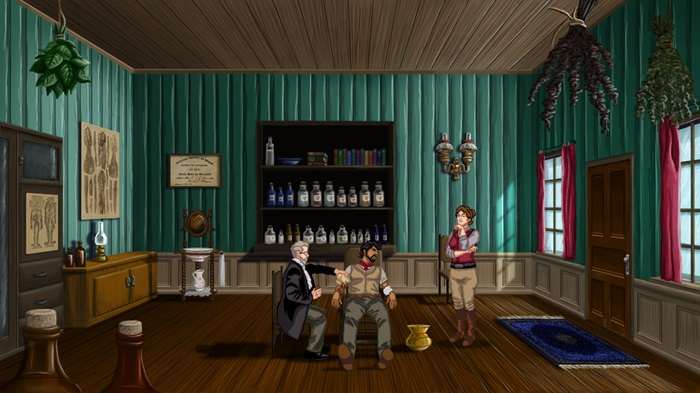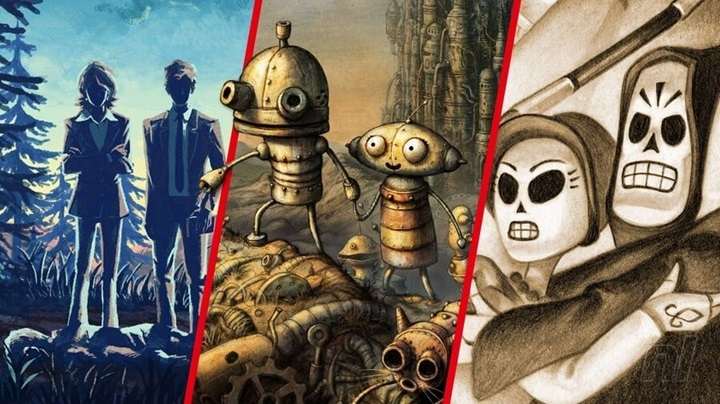Point and click games have a long-standing tradition in the gaming world, captivating players with immersive stories, challenging puzzles, and interactive environments. Unlike fast-paced action games, point and click games invite players to explore, think critically, and unravel narratives at their own pace. These games appeal to a wide range of players, from casual gamers looking for a relaxing experience to those who appreciate solving complex puzzles. In this article, we’ll explore the history, mechanics, and impact of point and click games, as well as some standout titles that have shaped the genre.
What Are Point and Click Games?

Point and click games are a genre of adventure games where players interact with the game environment by using a mouse or cursor. Players point to objects, characters, or locations on the screen and click to interact with them, whether it’s picking up items, talking to NPCs (non-playable characters), or solving puzzles. The emphasis is on exploration, problem-solving, and storytelling rather than fast reflexes or combat.
Key Features of Point and Click Games
- Interaction with Objects: Players can click on objects in the game world to examine or use them.
- Inventory System: Most games include an inventory where players store items they’ve collected to use later.
- Dialogue Choices: Many point and click games offer branching dialogue options, allowing players to choose how they interact with characters.
- Puzzle Solving: The core gameplay often revolves around solving puzzles to progress through the story.
- Non-linear Exploration: Players are free to explore the environment at their own pace, uncovering clues and secrets along the way.
The History of Point and Click Games
The Early Days: Text-Based Adventures
Point and click games trace their roots back to text-based adventure games of the 1970s and early 1980s. Titles like Zork and Colossal Cave Adventure set the stage for the genre by requiring players to type commands to interact with the game world. These early adventure games relied heavily on imagination, as there were no graphics, only descriptive text.
The Evolution to Graphical Adventures
The 1980s saw the rise of graphical adventure games, thanks to companies like Sierra On-Line and LucasArts. One of the earliest pioneers was Sierra’s King’s Quest (1984), created by Roberta Williams. It featured a fully graphical world where players could control a character using both keyboard commands and a cursor.
In 1987, Maniac Mansion, developed by Ron Gilbert for LucasArts, revolutionized the genre by introducing a mouse-based point and click interface, making the games more accessible and easier to control. This new interface removed the need for typing commands and allowed players to simply point and click on objects and characters to interact with them.
The Golden Age: 1990s Classics
The 1990s are often considered the golden age of point and click games. Some of the most iconic and beloved titles in the genre were released during this decade, many of which continue to influence game design today.
Monkey Island Series
The Secret of Monkey Island (1990) and its sequels are often hailed as some of the best point and click games ever made. Developed by LucasArts, the series is known for its witty humor, memorable characters (such as Guybrush Threepwood), and intricate puzzles.
Myst
Released in 1993, Myst was a groundbreaking game in the point and click genre. Unlike previous adventure games, Myst featured pre-rendered 3D environments and focused heavily on atmospheric exploration and environmental storytelling. Its success paved the way for more immersive, story-driven games.
Broken Sword
Broken Sword: The Shadow of the Templars (1996) by Revolution Software is another standout title from the 90s. This game combined historical conspiracy, clever puzzles, and rich, hand-drawn art to create a truly memorable experience.
The Decline and Resurgence of the Genre
By the early 2000s, the popularity of point and click games began to wane. As 3D action games and first-person shooters dominated the market, many believed that the genre was dead. However, the mid-2000s saw a resurgence of interest in point and click games, thanks to indie developers and the rise of digital distribution platforms like Steam and GOG.com.
Modern Point and Click Games
Today, the genre is alive and well, with both indie developers and larger studios continuing to release high-quality point and click games. These modern games often blend traditional mechanics with new storytelling techniques, creating experiences that appeal to both nostalgic fans and newcomers.
The Walking Dead (Telltale Games)
Telltale Games revitalized the genre in the 2010s with their episodic point and click adventures. The Walking Dead (2012) is one of the best examples, combining moral choices, emotional storytelling, and simple point and click mechanics. Its success led to a series of similar games from the studio, such as The Wolf Among Us and Tales from the Borderlands.
Life is Strange
Developed by Dontnod Entertainment, Life is Strange (2015) offers a modern take on the point and click genre by incorporating time manipulation mechanics and a focus on character-driven storytelling. Players make choices that impact the game’s narrative, making each playthrough unique.
Why Point and Click Games Are Still Relevant

Despite the explosion of high-budget action games, point and click games remain relevant for several reasons.
Storytelling and Emotional Depth
Point and click games are particularly well-suited to deep storytelling. The slow-paced gameplay allows for more nuanced character development, and the puzzles often tie directly into the narrative, making the story feel more immersive. Games like Grim Fandango, The Longest Journey, and Oxenfree are perfect examples of how point and click games can create emotional experiences.
Accessibility
The simplicity of point and click mechanics makes these games accessible to players of all skill levels. There’s no need for fast reflexes or complicated control schemes, which allows players to focus on the puzzles and story. This makes point and click games an excellent choice for casual gamers or those who prefer a more relaxed gaming experience.
Nostalgia and Retro Appeal
For many players, point and click games evoke a sense of nostalgia. Classics from the 90s like Monkey Island and Day of the Tentacle are still widely loved, and modern remasters and re-releases have introduced these games to a new generation. In addition, indie developers often draw inspiration from these older games, creating new titles with a retro feel.
Puzzle Solving and Critical Thinking
Point and click games challenge players to think critically and solve complex puzzles. These games often require creative thinking and attention to detail, making them rewarding for players who enjoy problem-solving. Titles like The Witness and Machinarium offer intricate puzzles that can be both satisfying and mentally stimulating.
Notable Point and Click Games
There are hundreds of point and click games worth exploring, but here are a few standout titles that represent the best the genre has to offer:
1. The Secret of Monkey Island (1990)
A hilarious pirate-themed adventure, The Secret of Monkey Island is known for its witty dialogue, memorable characters, and inventive puzzles.
2. Grim Fandango (1998)
Set in a world inspired by Mexican folklore, Grim Fandango combines a noir detective story with point and click gameplay, creating a truly unique experience.
3. Machinarium (2009)
An indie hit, Machinarium is a beautifully crafted game with hand-drawn art, a melancholic robot protagonist, and a variety of clever puzzles.
4. Broken Sword: Shadow of the Templars (1996)
This classic adventure game blends historical intrigue with clever puzzles and charming hand-drawn visuals.
5. The Walking Dead (2012)
Telltale’s The Walking Dead breathed new life into the genre with its focus on emotional storytelling and player choices.
The Future of Point and Click Games
As game development tools become more accessible and digital distribution continues to grow, the future of point and click games looks bright. Indie developers, in particular, are pushing the boundaries of what the genre can achieve, experimenting with new ways to tell stories and engage players. Whether through virtual reality, innovative mechanics, or emotionally-driven narratives, point and click games are evolving while still maintaining their core appeal: immersive storytelling, engaging puzzles, and a sense of exploration.
Related Post:
Big Brother Reindeer Games: A Winter Wonderland of Competition
2 Player Games Unblocked: The Ultimate Guide to Fun and Friendly Competition
OVO Cool Math Games: A Complete Guide to Mastering the Game
Point and click games have had a profound impact on the gaming industry, and their appeal shows no sign of fading. Whether you’re revisiting classics like Monkey Island or diving into modern titles like Life is Strange, the genre offers something for everyone. These games provide a unique blend of storytelling, exploration, and puzzle-solving that continues to captivate players across generations.
Whether you’re a seasoned fan or a newcomer, point and click games are an essential part of the gaming landscape, inviting players to slow down, think critically, and immerse themselves in rich, imaginative worlds.


